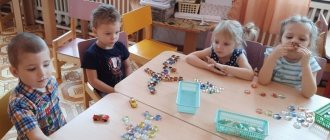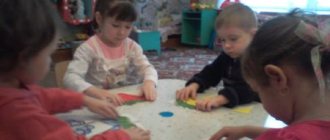Lesson notes for a teacher-psychologist on team building for children in the second junior group
Lesson notes for a teacher-psychologist
MBDOU "Kindergarten" Cherry village. Red"
to unite the children's team
Topic: "Mood
».
Target:
relieving accumulated internal tension, developing the ability to express oneself, and uniting the group. Train children to convey their mood through color spots depicted on a sheet of paper.
Equipment:
recording music while visiting a fairy tale, sounds of nature, masks for characters from the fairy tale “Turnip”, paints, brushes, drawing paper.
Progress of the lesson.
Quiet music is playing in the psychologist’s office, children enter in a flock, and the teacher asks everyone to stand in a circle.
Welcome ritual.
Exercise “Hello friend”
Goal: Creating an atmosphere of psychological safety and group unity.
Procedure: Children stand in a circle and pass a heart to each other. Each child greets a friend by name.
After the greeting, the teacher invites the children to sit down on the carpet. The teacher asks the children to remember what fairy tales they know? Children list the fairy tales they know one by one. The psychologist suggests staging the fairy tale “Turnip”. Fairy tale characters are selected. The game begins.
At the end of the game, the teacher invites the children to sit down at the tables.
Exercise “Drawing your mood”
Goal: throw out your emotions, worries, fears, negativity onto paper.
The psychologist invites children to choose the color of paint they want, to draw color spots and lines. (The use of black and purple colors indicates a depressed mood and a lot of fears.)
At the end of the work, the children talk about their drawing, what they experienced while depicting their mood, and what difficulties they encountered. The psychologist keeps the work for himself for further interpretation.
Exercise "Bell".
Goal: to establish contact between group members, to focus children’s attention on each other.
The teacher announces that the lesson is coming to an end, asks the children to remember what new they learned, what feelings they experienced during the lesson. Thanks everyone for their active participation.
Topic: “We love you”
Target:
Forming a sense of closeness with other people, children’s acceptance of each other, developing a sense of the value of others and self-worth. Emotional support, establishing trusting relationships.
Equipment:
recording music while visiting a fairy tale, sounds of nature, a ball of thread.
Progress of the lesson.
Quiet music is playing in the psychologist’s office, children enter in a flock, and the teacher asks everyone to stand in a circle.
Welcome ritual.
Exercise “Hello friend”
Goal: Creating an atmosphere of psychological safety and group unity.
Procedure: Children stand in a circle and pass a heart to each other. Each child greets a friend by name.
The psychologist invites everyone to sit down on the carpet.
Goal: Forming a feeling of closeness with other people.
Children, sitting in a circle, pass a ball of thread. The transfer of the ball is accompanied by statements about what the one holding the ball feels, what he wants for himself and what he can wish for others. If there is difficulty, the psychologist helps the child by throwing the ball to him again. This technique is diagnostic: you can see children experiencing difficulties in communication - the presenter will have double, triple connections with them. When the ball returns to the leader, the children pull the thread and close their eyes, imagining that they form one whole, that each of them is important and significant in this whole.
At the end of the exercise, the teacher invites all children to stand in a circle.
Goal: Creating an atmosphere of unity, developing the ability to express one’s emotional state.
Participants stand in a circle and hold hands. Everyone takes turns giving a smile to their neighbors on the left and right, it is important to look into each other’s eyes.
Reflection: How did you feel? What's your mood now? Children share their impressions and feelings.
The presenter invites each child to affectionately name the neighbor sitting on the right, who must certainly thank the speaker by saying “Thank you.”
The teacher announces that the lesson is coming to an end, asks the children to remember what new they learned, what feelings they experienced during the lesson. Thanks everyone for their active participation.
Topic: “Good and bad deeds”
Target:
To train children in the ability to distinguish between “good” and “evil” and to be aware of their actions.
Equipment:
recording music visiting a fairy tale, relaxation music, pictures depicting good and bad weather, soft toy sun,
Progress of the lesson.
Quiet music is playing in the psychologist’s office, children enter in a flock, and the teacher asks everyone to stand in a circle.
Welcome ritual.
Exercise “Give a smile.”
Goal: Goal: Creating an atmosphere of psychological safety to unite the group.
Progress of the exercise: Children stand in a circle and pass the sun to each other. Each child smiles at the neighbor on the right and says hello.
Exercise “Mood Forecast”.
Goals: to teach to recognize emotional states (your own and others); teach to be attentive to the manifestations of the feelings and desires of others; learn to convey your mood through different means (in expressive movements, in drawing); develop skills for psychocorrection of negative emotions. The teacher reads the poem and accompanies the text with expressive movements according to the text (performs together with the children):
King Borovik walked straight through the forest, He shook his fist and tapped his heel. King Borovik was not in good spirits: the king was bitten by flies.
Discussion. Questions:
What was King Borovik's mood? Why? How did you know that he was angry and angry?
Continuation of the story: King Borovik came home angry and angry. He wanted peace and quiet for at least some time, so that no one would disturb him. I thought and thought about how to do this, and came up with it! He drew his bad mood in the form of bad weather. Like this ( the presenter shows the drawing
): dark, thunderclouds and bright lightning. He hung the drawing on the door and said: “Let's see if anyone will guess that the drawing is a forecast of my mood?”
Then he turned on quiet, calm music, lay down on the sofa and began to remember what was good in his life. ( At this moment, relaxation music is turned on, then the story goes on against its background
). And then he wanted to mentally change his “bad” drawing: the lightning disappeared; dark, stormy clouds began to become lighter and lighter; The sun began to peek out more and more from behind the clouds. And finally, all that was left was the bright sun, which, delighting everyone with its radiance, seemed to say: “Draw the sun in your heart and you will feel good!”
A bunny named “Kind Man” passed by, heard unusual beautiful music and decided to visit the king. But when he saw a drawing on the door depicting bad weather, he immediately realized that the king had to be left alone for a while. An hour later, he saw a drawing of a bright sun on the king’s door and realized that now he would be a welcome guest.
(The music plays for another 3 minutes; children are encouraged to think about pleasant things.)
Discussion. Questions:
1) In what way did King Borovik show that he was in a bad mood? 2) Why did the bunny decide not to go to the king? 3) How did the bunny know that the king was in a good mood? 4) How can you show other people what mood you are in? 5) Should I wait until the bad mood passes? 6) What to do to make a bad mood good? 7) List thoughts that create a good mood.
We learn techniques to help correct a bad mood.
Conclusion: Everything will be fine if:
listen to calm music;
think about good and pleasant things;
mentally replace the picture of “bad” weather with “bright and sunny”;
“light up” the sun in your heart;
Homework assignment. Monitor your mood throughout the week and try to correct it using the rules that we have learned.
Goal: Group cohesion, development of the ability to concentrate and a sense of responsibility.
Participants stand in a circle holding hands. The teacher asks everyone to close their eyes and gives some signal (shake hand twice, raise your hand up, etc.). The one who receives the signal from the right or left must pass it on to the next one in the chain. The game is over when the teacher receives the signal transmitted by him. The game uses the “damaged phone” principle. Repeats several times.
Reflection. The psychologist asks the children what difficulties they experienced while playing the game “Pass the Signal.”
Exercise "mirror"
Goal: Awakening the activity of each child, they learn to obey certain rules, which organizes, disciplines and unites playing children.
Now we propose to complete several simple tasks, or rather, to simulate their implementation. Listen to the assignments carefully. There are only four of them. The tasks are as follows:
1) sew on a button;
2) getting ready to go on the road;
3) bake a pie;
4) we perform in the circus.
The peculiarity of these tasks is that you will perform each of them in pairs, and the partners will stand opposite each other, and one of them will temporarily become a mirror, i.e. will copy all the movements of its partner. Then the partners change roles. But first, let's break into pairs. Please. The pairs are ready, let's start the tasks. So, all pairs take turns performing tasks of their choice. One of them is the performer, and the other is his mirror image, imitating all the movements of the performer.
The teacher announces that the lesson is coming to an end, asks the children to remember what new they learned, what feelings they experienced during the lesson. Thanks everyone for their active participation.



